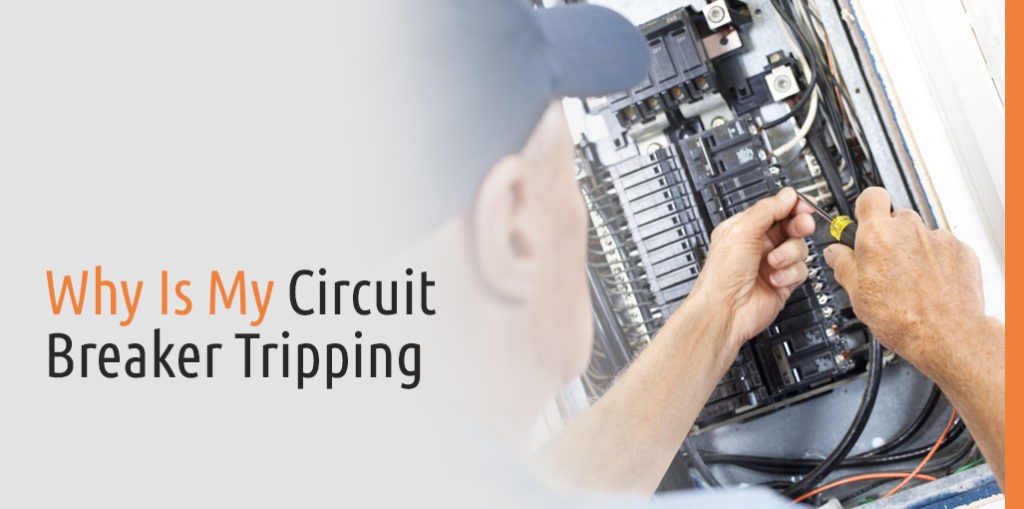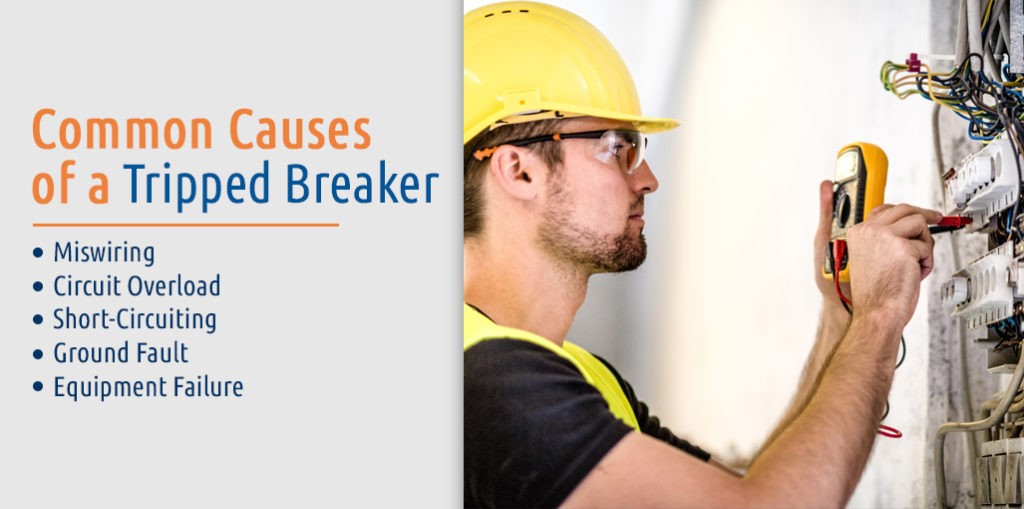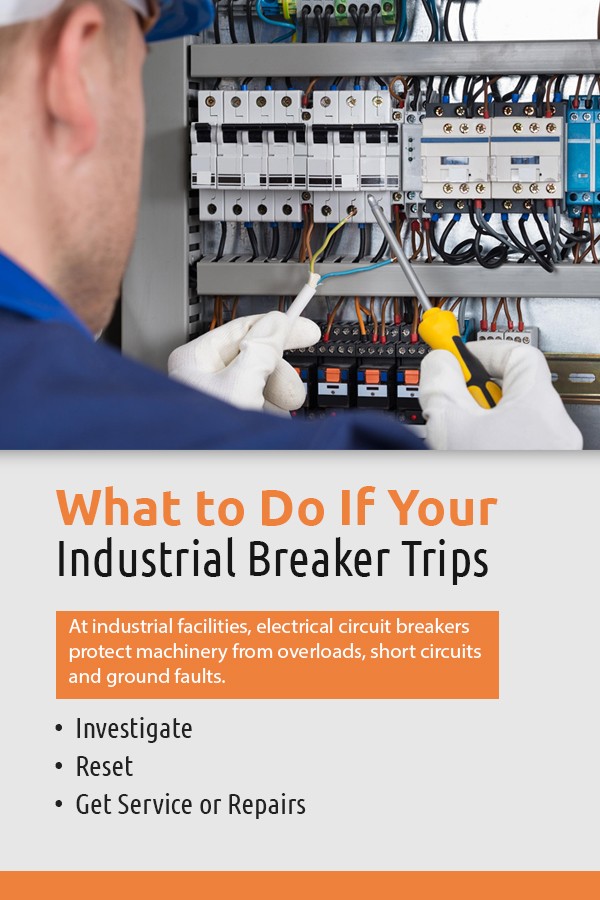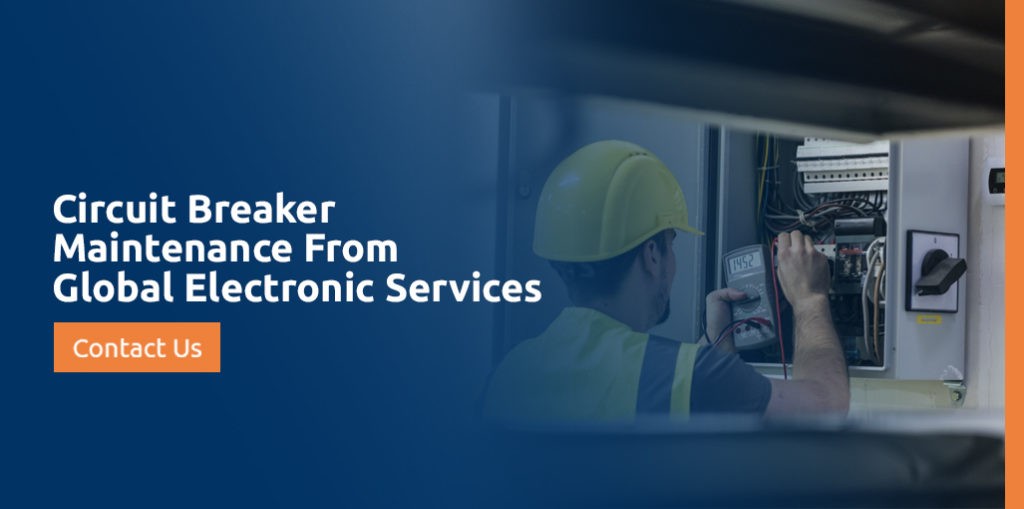Why Is My Industrial Circuit Breaker Tripping

In factories and pressing plants, vast arsenals of machinery rely on high-voltage power supplies. For all the components to function as intended, the electrical circuit must meet the demand, and no machine can overdraw on the current flow. If the balance is broken for even a millisecond, circuit breakers trip. Whether circuit overload or ground faults caused the trip, the issue must be identified, understood and remedied to avoid a more severe set of problems.
How Industrial Circuit Breakers Differ
Industrial circuit breakers are designed to handle maximum amounts of voltage. Without a circuit breaker, the electrical distribution would not be possible at industrial facilities. The purpose of the circuit breaker is to break potential overload in an electrical current. That way, if an excessive amount of voltage comes before the circuit breaker at any given second, the breaker prevents the voltage from making its way to the factory equipment.

Industrial circuit breakers differ in terms of their design, features and voltage. Technically, circuit breakers fall into three classifications — low voltage, medium voltage and high voltage. Regardless of the classification or structural features, all circuit breakers are designed to protect factory workers and equipment from the danger of power surges.
An electrical circuit breaker works by automatically switching off the moment an overload occurs. Circuit breakers prevent an overload from reaching the equipment at an industrial facility and causing short circuits and fires. While the industrial circuit breaker is designed to protect factories and workers from potential harm, qualified technicians need to manage them with care, since accidents can and do happen during instances of mishandling.
Why Do Circuit Breakers Trip?

In an industrial facility, one of the biggest impediments to productivity is the sudden and complete loss of power that occurs when a breaker trips and cuts off all electricity. When large-scale productions are underway, the setbacks caused by a tripped breaker could result in astronomical financial losses for the parties involved. Tripped breakers are usually due to one of the following problems:
Miswiring
A common reason for a circuit to break is miswiring, where select wires are not correctly connected within the circuit breaker. Miswiring can cause a circuit breaker to work improperly or fail to function in any capacity. In some cases, miswiring could prevent an industrial circuit breaker from shutting off in an instance of overflow. In other instances, miswiring could render a circuit breaker inactive when you try to power it on at the start of a new shift. Either way, the risks posed by miswiring can be dangerous, costly and sometimes fatal.
Miswiring can also occur when a circuit breaker is subjected to faulty maintenance. If a technician makes a mistake and wires the connections improperly during routine maintenance on an industrial circuit breaker, the results could have numerous consequences. In some instances, a technician could easily incur an electrical shock when touching a miswired unit.
Miswiring could also be the result of a circuit breaker that has not been maintained at the necessary intervals. For example, if the unit has been exposed to steam and vapor in cold temperatures, some of that moisture could make its way inside the unit and gradually cause corrosion. Once rusting begins, it could spread to the wires and cause connection failures.
Rodents could also cause miswiring. If a small rat manages to squeeze its way into a circuitry box, the critter is liable to spend its time gnawing at the wires inside until something snaps. In all likelihood, a rat that causes wire damage would end up electrocuted, in which case there would soon be a telling smell seeping from the circuit compartment. In any case, foul odors from a circuit breaker could indicate that something is wrong with the wiring and that the functions should not be activated until the issue is resolved.
Circuit Overload
When a power source is drawn beyond its allowance, the circuit breaker is liable to trip due to overload. At an industrial facility, overloading can occur when too many machines or tools are connected to the same power source. Despite the high thresholds of most industrial breakers, there are still limits to the amount of power that can be drawn from a single source. If too many high-power pieces of equipment are active simultaneously, the power source could become overloaded and cause the breaker to shut off the power as a protective mechanism.
Circuit overload could easily happen in an industrial facility when a new piece of equipment is set up in an area that is already tapped out with pre-existing instruments. Once this new machine or tool is connected and activated, the amperage is instantly exceeded, and this trips the circuit breaker. In this situation, overload could result if the breaker is maxed out with pre-existing tools or if the demands of the new machine are beyond the threshold of the power supply.
Larger machines generally require more amperage than smaller ones, especially if the machine generates heat. Each class of circuit breaker has its own amp rating, as indicated by the size of the unit. A large industrial circuit breaker will usually be equipped for some of the most energy-intensive machines on the market. Still, factory technicians must check the amp rating on a circuit breaker before attaching a new electrical device.
Short-Circuiting
When an electrical current passes without interruption along an unintended path, this is known as a short circuit, whereby excess amperage flows through the circuit with no impedance. In a circuit breaker, a short circuit will occur when one hot wire comes into contact with another and sparks fly at the point of contact.
A short circuit could follow an instance of overload where the excess amperage causes a wire to overheat and potentially spark a fire. As the overloaded current passes along the wire, the heat could burn away at the insulation and burst into flames. The resulting damage could either be localized or pervasive, depending on whether the short comes in contact with additional currents. If the sparking tip makes contact with another loose wire, that could send the short along a further path and present even more danger.
In a miswired or unwired circuit breaker, a short circuit could occur if the two loose wire ends make contact and spark. In some cases, short circuits are one of the lingering results of structural damage to an electrical facility, such as when an earthquake or hurricane passes through and leaves power lines in disarray.
Ground Fault
A ground fault occurs when a hot wire comes into contact with a ground wire. In such instances, outlets to the ground wire are rendered dangerous if cords or people make contact. When a ground fault occurs at an industrial facility, any technician who unknowingly plugs or unplugs a cord from an affected outlet could be electrocuted.
Ground faults are also known as earth faults because the problem is characterized by unintentional contact between circuit conductors and the earth. When such contact is made, the ensuing faults will usually spread dangerous currents. If contact is made with the attached circuit breaker, the victim is liable to incur a shock at a lethal voltage.
In some instances, a single ground fault can be tolerated without any interruption to a company’s operations. For example, if a power distribution system is fortified to account for the possibility of at least one ground fault, the problem might not send shocks or cause any immediate danger to structures or workers. Still, the problem should be rectified upon discovery.
Today, many buildings and factories are equipped with insulation monitoring devices that detect instances of ground faults and alert such matters to on-premise electrical technicians. This allows technicians to identify the source of the issue and perform the necessary procedures to remedy the problem. If a second ground fault occurs, it’s harder for any in-built system thresholds to withstand the overcurrents generated by the unintended contact.
Consequently, situations with two ground faults often result in damage to affected electrical components.
Equipment Failure
In some cases, breaker trips are not caused by the power source. Instead, the problem originates from a particular appliance that draws too much energy for the circuit breaker to accommodate within its voltage limit. The problem might not even stem from a new device with exceeding power demands, but from a pre-existing component that suddenly draws more than its stated requirements. Problems like these are generally due to equipment failure, where the machine or tool in question now draws more power than before because the normal dosages no longer offer sufficient energy for the functions at hand.
Equipment failure can be one of the more difficult problems to remedy in an industrial setting because the source can be hard to pinpoint among large arsenals of equipment. In a factory equipped with many machines and tools, the trips could be down to one of many suspects. One of the most effective methods of isolating the source of the problem is to gauge the temperature of each recently active device. If a machine or tool emits an uncharacteristically hot temperature, that device has probably drawn too much energy from the power source due to internal failures.
Circuit breaker trips can sometimes occur when a machine that already requires maximum voltage suddenly lags internally and demands more power. For example, if a machine motor runs continuously without sufficient lubrication, the motor parts could start to grind against one another and cause friction, corrosion and rust. As the motor drags and grinds, the machine might draw more power to perform its basic functions. If a sudden power demand exceeds the voltage limit of the circuit breaker, the surge could cause a breaker trip and abruptly shut everything off across the factory floor.
In many instances, breaker trips that stem from equipment failure are the result of poor maintenance for the machines in question. When the internal parts of a machine are not inspected periodically, certain parts could gradually become worn from constant use. Therefore, it is crucial to grease the joints, test the belts and clear the vents inside a machine at regular intervals. Otherwise, the strain endured by the machine could lead to internal damage, costly repairs, breaker trips and stalled productions.
What to Do If Your Industrial Circuit Breaker Trips

At industrial facilities, electrical circuit breakers protect machinery from overloads, short circuits and ground faults. As such, circuit breakers should be inspected at least once every 12 months and given trip tests every three years to ensure that everything is in proper working condition. It is also crucial to maintain a clean area around the circuit breaker, as even the slightest amount of dust or dirt that comes into contact with any of the moving parts could cause problems.
Investigate
When a circuit breaker trips, the unit should be investigated to determine the cause of the issue. Inside the circuit breaker, the evidence could be revealed by a flipped switch or melted covering. If the trip results from overload, all the machines connected to the flipped switch should be examined for excess heat or signs of motor wear. Any machine that has not been in use should be disconnected as it could still be a drain on the energy supply, even while left in an idle state.
Reset
If most of the switches are pointed in the same direction, and one is pointed the other way, the circuit breaker could easily be reset with a simple flip of the switch. However, that switch will have flipped for a reason, such as an overload, short circuit or ground fault. Therefore, it is essential to isolate the problem before resetting the circuit breaker. Without any service or maintenance, a simple reset could lead to more costly and dangerous issues.
Get Service or Repairs
In most cases, a licensed technician should examine a tripped circuit breaker. Unless the cause of the trip is obvious and instantly reversible, such as a new machine that requires too much amperage, do not reset the breaker until the issue has been professionally diagnosed and remedied. In light of a trip, a professional technician will examine the wires, switches and attached components to determine whether the issue stems from overload, miswiring, equipment failure or something more dangerous, such as short circuits or ground faults.
Circuit Breaker Maintenance From Global Electronic Services
Inspect and service your industrial circuit breakers periodically to prevent tripping and all the associated damages. If a trip does occur, bring in professional help immediately.
At Global Electronic Services, our team performs repair and service work on industrial electronics. Contact GES Repair with questions concerning your factory’s circuit breaker.
